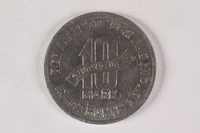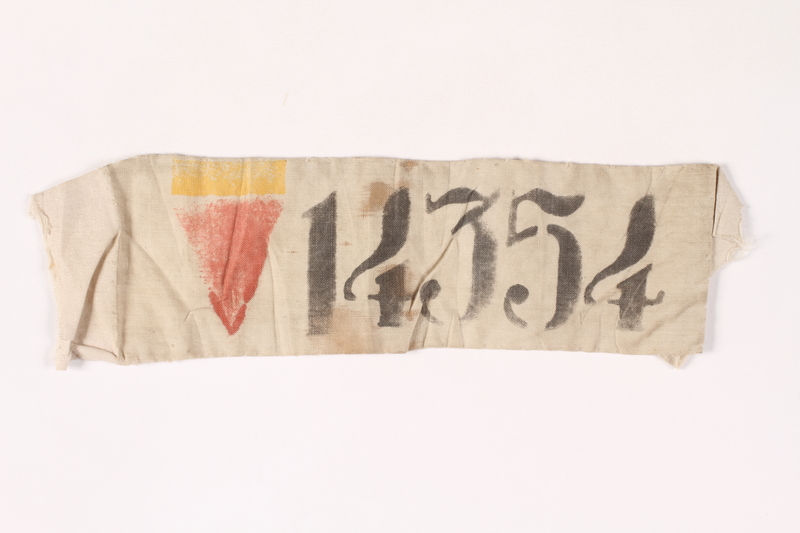Overview
- Brief Narrative
- Prisoner identification patch owned by Ilona Winograd and believed to be the one worn by her mother Bella when they were imprisoned in Ravensbrück concentration camp from October 1944-May 1945. Germany occupied Poland in September 1939. Her parents Bella and Marek lived in Łódź and were imprisoned in the ghetto where Ilona was born in 1940. On September 5-12, 1942, the Germans conducted a mass deportation, targeting hospital patients, the elderly, and children; over 12,000 people were deported to Chelmno killing center. Ilona was not included in the round-up because she was the child of an essential Jewish Council employee; her father was in charge of ghetto housing. With other children, Ilona was hidden in a hospital until the Aktion ended. When the ghetto was liquidated in October 1944, Ilona and her mother were sent to Ravensbrück and her father was sent to Oranienburg. They were reunited when the war ended in May 1945. They walked back to Łódź and searched unsuccessfully for relatives. They left for Sweden in 1946 because of postwar antisemitism.
- Credit Line
- United States Holocaust Memorial Museum Collection, Gift of Ilona W. Barkal
- Contributor
-
Subject:
Ilona Barkal
- Biography
-
Ilona Winograd was born in the Łódź Ghetto on German occupied Poland on January 15, 1940, to Bajla (Bella) Kozak and Marcus Marek Winograd. Bajla was born on December 12, 1909, and was a Strasbourg educated bacteriologist. Marcus, born on May 18, 1903, was a textile engineer. Thier families lived next door to each other. Bella's family had a newspaper distribution business and Marek's family ran a clothing store. The couple married on February 2, 1938. Germany invaded and occupied Poland in early September 1939. In February, the families were forced into a Jewish ghetto. Bella and Marek lived with their extended family, including Ilona’s paternal grandparents, Luba and Nuchem, maternal grandparents, Ita and Moshe, and three maternal uncles, Szmul, (1910-1944), Fabian, (1907-1943), and Izio, d. 1941. Marcus worked for the Jewish Council and was in charge of housing. Bajla worked as a bacteriologist in the laboratory at 3 Zgierska Street. From September 5-12, 1942, 12,000 Jews were deported to Chelmno extermination camp during the Gehsperre Aktion. The ghetto hospital was closed, and the patients were the first to be deported, followed by the elderly, the infirm, and children. Ilona was two and a half years old, but was exempted from deportation because she was the child of a Jewish Council essential employee. During the Aktion, each exempted child was issued a round, wooden tag with their name and required to wear it around their neck. The group of 226 children were hidden in the hospital on Lagiewnicka Street, until the Aktion ended. In August 1944, as the ghetto was being emptied of all residents through mass deportations, the Winograd family was permitted to stay until October. On October 21, 1944, a group of 600 Jews, including Ilona and her parents, known as Biebow's Jews, after the Nazi administrator of the ghetto, Hans Biebow, were taken to Konigs Wusterhausen concentration camp, near Berlin. Ilona and Bella were transported to Ravensbrück concentration camp and Marcus was sent to Oranienburg concentration camp. Ilona's mother, with her skills as a scientist, would drug Ilona to keep her still and quiet during times of danger in the camp. On April 27, 1945, the Soviet Army liberated the area and Ilona, Bella, and Marcus were reunited. The family walked back to Łódź and searched unsuccessfully for any remaining family members. Bella found work as a laboratory technician but, in 1946, the family left for Sweden because of the intense antisemitism in Poland. Ilona received a degree in dentistry and emigrated to Israel in 1970.
Physical Details
- Classification
-
Identifying Artifacts
- Category
-
Badges
- Object Type
-
Prisoner badges (ushmm)
- Physical Description
- Rectangular, discolored and soiled white cotton patch with a hand-applied, yellow bar above an inverted red triangle next to the prisoner number 14354 in black ink. There are brown stains in the center. All edges are frayed. The long edges are pressed over to the back. The short edges have a deep crease with a line of pin holes, possibly from being folded and pinned to clothing.
- Dimensions
- overall: Height: 2.000 inches (5.08 cm) | Width: 7.750 inches (19.685 cm)
- Materials
- overall : cotton, ink
- Inscription
- front, hand applied, black ink : 14354
Rights & Restrictions
- Conditions on Access
- No restrictions on access
Keywords & Subjects
- Topical Term
- Child concentration camp inmates--Germany--Ravensbruck. Concentration camp inmates--Germany--Ravensbruck. Hidden children (Holocaust)--Poland--Łódź. Holocaust survivors--Sweden. Holocaust, Jewish (1939-1945)--Poland--Łódź. Jewish children in the Holocaust--Poland--Łódź. Jewish ghettos--Poland--Łódź.
- Geographic Name
- Poland--History--German occupation, 1939-1945--Money.
Administrative Notes
- Legal Status
- Permanent Collection
- Provenance
- The badge was donated to the United States Holocaust Memorial Museum in 2015 by Ilona Winograd Barkal.
- Funding Note
- The cataloging of this artifact has been supported by a grant from the Conference on Jewish Material Claims Against Germany.
- Record last modified:
- 2022-07-28 21:51:35
- This page:
- https://collections.ushmm.org/search/catalog/irn538408
Download & Licensing
In-Person Research
- By Appointment
- Request 21 Days in Advance of Visit
- Plan a Research Visit
- Request to See This Object
Contact Us
Also in Ilona Winograd Barkal collection
The collection consists of artifacts, documents, and photographs relating to the experience of Ilona Winograd Barkal and her parents, Bella and Marcus Winograd, in Łódź, Poland before, during, and after the Holocaust during which they were separated and deported to different concentration camps.
Date: 1937-1946

Identification tag that exempted a Jewish child from deportation
Object
Identification tag that protected two and half year old Ilona Winograd from deportation in the Łódź ghetto. In 1941, Ilona and her parents, Bella and Marek, were imprisoned in the ghetto after the 1939 German occupation of Poland. From September 5-12, 1942, the Germans conducted a mass deportation, targeting hospital patients, the elderly, and children; over 12,000 people were deported to Chelmno extermination camp. Ilona was not included in the round-up because she was the child of an essential Jewish Council employee; her father was in charge of ghetto housing. During the Aktion, each exempted child was issued a round, wooden tag with their name and required to wear it around their neck. The children were hidden in the hospital on Lagiewnicka Street until the Aktion ended. When the ghetto was liquidated in October 1944, Ilona and her mother were sent to Ravensbrück concentration camp and her father was sent to Oranienburg. They were reunited when the war ended in May 1945. They walked back to Łódź and searched unsuccessfully for relatives. They left for Sweden in 1946 because of postwar antisemitism.

Łódź (Litzmannstadt) ghetto 10 mark coin owned by a former child internee
Object
10 mark coin token issued in Łódź Ghetto owned by Ilona Winograd who was born in the ghetto in 1940. Ilona's parents Bella and Marek were forced into the ghetto after the September 1939 German invasion of Poland. From September 5-12, 1942, the Germans conducted a mass deportation, targeting hospital patients, the elderly, and children; over 12,000 people were deported to Chelmno killing center. Ilona was not included in the round-up because she was the child of an essential Jewish Council employee; her father was in charge of ghetto housing. When the ghetto was liquidated in October 1944, Ilona and her mother were sent to Ravensbrück concentration camp and her father was sent to Oranienburg. They were reunited when the war ended in May 1945. They walked back to Łódź and searched unsuccessfully for relatives. They left for Sweden in 1946 because of postwar antisemitism.
Ilona Winograd papers
Document
Collection consisting of three identification cards, one letter, and three photographs documenting the experiences of the Winograd family in Łódź during the time period surrounding the Holocaust. The collection includes pre-war identification issued to Bella Winograd (donor's mother) that was hidden during the war; Red Cross letter inquiring about the family, work card issued to Bella Winograd in the Łódź ghetto, post-war identificationcard issued to Bella Winograd, and war time photographs of Ilona Winograd. The Winograds were separated in October 1944 after they were taken to Koenigswusterhausen near Berlin. Bella Winograd and Ilona were sent to Ravensbrück and Marek Winograd (donor's father) was sent to Oranienburg. They reunited after liberation and returned to Łódź to search for their family.




